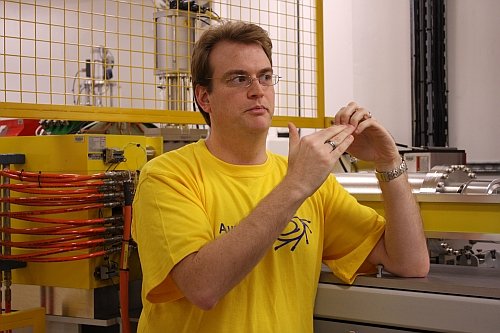Hidden behind white concrete walls, the electron storage ring of the Australian Synchrotron light source might easily be forgotten as simply a device for generating light. To the accelerator physics team, however, it is a state-of-the-art experimental apparatus that is rich in both physics and fascination – and many times more interesting than any beamline.
While the team’s first responsibility is to ensure the delivery of high quality photon beams to the beamlines, the smooth operation of the Australian Synchrotron accelerator systems allows the team to conduct research into acceleration techniques that will improve current accelerators as well as paving the way for future machines.
One area of recent study has pushed the performance of the Australian Synchrotron storage ring into the international accelerator community ‘spotlight’. Accelerator physicist Rohan Dowd and his colleagues have achieved a world-record low vertical emittance of only 1.2 picometre radians, significantly lower than the previous record for an electron beam. The research is described in the Physical Review Special Topics : Accelerators and Beams journal (R. Dowd, et al., “Achievement of ultralow emittance coupling in the Australian Synchrotron storage ring” http://link.aps.org/doi/10.1103/PhysRevSTAB.14.012804).
Emittance is a quantity that describes the spread of position and angle of the individual particles in the beam, in this case electrons. A beam with a small emittance is small in size and well collimated. The magnitude of the beam’s emittance in an electron storage ring is determined by the equilibrium between processes that cause it to grow, such as passage through bending magnets, and those that damp it, such as emission of synchrotron radiation. Since most bending happens in the horizontal plane, the horizontal emittance is much higher than the vertical emittance. In fact, the vertical beam emittance is almost completely dominated by coupling of the horizontal emittance into the vertical plane through small magnet misalignments.
The record low vertical emittance was achieved by employing a novel beam analysis technique to determine the best configuration of magnet settings to minimise coupling in the storage ring. Because of the extremely low vertical beam size resulting from this emittance (only a few micrometres high in places) it was not possible to use our current diagnostic equipment to directly measure the beam emittance using optical techniques.
Instead we had to use indirect measurements, inferring emittance by measuring other characteristics such as beam lifetime. Indirect measurements are often complicated by assumptions and uncertainties not present in a direct measurement. To prove the validity of our indirect measurements, we conducted a painstaking series of independent measurements under differing conditions and cross-checked these against each other.
As well as demonstrating great achievements in accelerator alignment and beam control at the Australian synchrotron, the result has implications for future accelerator design. Researchers involved in the proposed International Linear Collider (ILC) and Compact Linear Collider (CLIC) projects are keenly interested because this is the first demonstration of a vertical emittance of the magnitude that they require in the damping rings of these colliders. The Australian Collaboration for Accelerator Science (www.accelerators.org.au), of which the Australian Synchrotron is part, recently signed a memorandum of understanding with CERN to participate in design work for the CLIC project, concentrating on damping ring design and RF (radiofrequency) structure analysis. Emittance tuning techniques will be a key area of this design work, drawing on experience gained on the Australian Synchrotron storage ring.
 Caption: Accelerator physicist Rohan Dowd shares his fascination with synchrotron storage ring physics at a recent Open Day.
Caption: Accelerator physicist Rohan Dowd shares his fascination with synchrotron storage ring physics at a recent Open Day.
